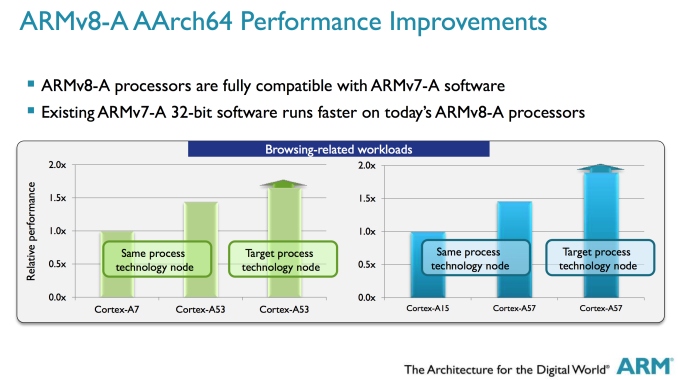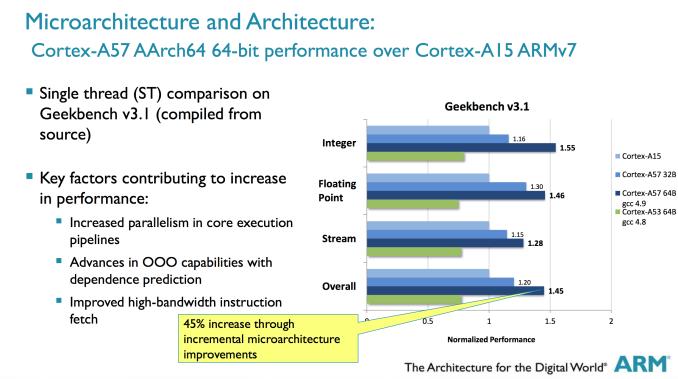ARM Shares Updated Cortex A53/A57 Performance Expectations
by Anand Lal Shimpi on May 6, 2014 8:00 AM EST- Posted in
- SoCs
- CPUs
- Arm
- Cortex A53
- Cortex A57

With the first Cortex A53 based SoCs due to ship in the coming months, and Cortex A57 based designs to follow early next year, ARM gave us a quick update on performance expectations for both cores. Given the timing of both designs we'll see a combination of solutions built on presently available manufacturing processes (e.g. 28nm) as well as next gen offerings (20/16FF). The graph above gives us an updated look at performance expectations (in web browsing workloads) for both ARM 64-bit cores.
If we compare across the same process nodes (28nm in both cases), the Cortex A53 should give us nearly a 50% increase in performance compared to ARM's Cortex A7. The Cortex A57 should offer roughly the same increase in performance compared to Cortex A15 as well. Although the A57 will do so at higher power, power efficiency may be better depending on the workload thanks to the added performance. Thankfully we won't see many A57 designs built on 28nm in mobile (AMD's first Cortex A57 design will be aimed at servers and is built on a 28nm process).
If you combine architectural improvements with a new process node, the gains are substantial. Move to 20nm or 16FF for these designs and the improvement over their 32-bit predecessors easily exceeds 50%.
ARM also provided some Geekbench 3 performance data comparing the Cortex A57 to A15, both in 32-bit and 64-bit mode. We already know Geekbench 3 is particularly sensitive to the new instructions that come along with AArch64, but even in 32-bit mode there's still a 15 - 30% increase in performance over the Cortex A15 at the same clocks.
Qualcomm has already announced its Snapdragon 410, 610 and 615 will use ARM's Cortex A53, while its 808 and 810 will use a combination of Cortex A53s and A57s.











37 Comments
View All Comments
michael2k - Tuesday, May 6, 2014 - link
QC is in every flagship android phone right now because no one else has a workable replacement (ie, everyone is in the same boat) so they might as well leverage QC's radio integration. That however isn't a static relationship as both Intel and NVIDIA have their own integrated radios and their own higher performance SoC as well as competitive GPUs coming out this year.bigstrudel - Tuesday, May 6, 2014 - link
They're using stock designs to make up for it. I'd say they absolutely missed the boat that Apple launched and left without them.drexnx - Tuesday, May 6, 2014 - link
and yet they're still capturing design wins to boot, so no skin off their back. They're still selling chips.They can't expect to be ahead for 2+ years on one uarch anyway.
look at it this way:
Scorpion was better than A8 for about 18 months, then inferior to full A9 (A9 with NEON. Tegra 2 doesn't count since it traded blows evenly with higher clocked snap S2s, and until the OMAP4430 and Exynos 4210 came out, the snap S3 then killed the Tegra 2) for a year before Krait came along. Krait is better than A9 and A15, and has been since launch in 1-2012... so A57 will beat Krait for 9-12 months... big deal, Krait's successor will be out soon enough anyway.
basically, QC's custom core designs have been better than vanilla ARM for something like 66-75% of the time since scorpion came out way back in 2008 - that's pretty damn good.
Seriously, are there any viable flagship non-proprietary SoC competitors left anyway? TI is gone, Nvidia is a joke, ST-Ericsson dissolved
drexnx - Tuesday, May 6, 2014 - link
I guess that's why QC has 64% marketshare in SoCs and the next closest competitor has 12%.they're really doomed.
tuxRoller - Wednesday, May 7, 2014 - link
Clock for clock, krait is pretty inferior to a15.CharlieSD11 - Wednesday, May 7, 2014 - link
How is it missing the boat when there isn't a 64-bit OS released yet to pair with a 64-bit CPU? If Android or Windows Phone was 64-bit today then I would think you could say they missed the boat and should have seen this coming.bigstrudel - Wednesday, May 7, 2014 - link
By miss the boat I mean MediaTek beat them to 64bit.tuxRoller - Wednesday, May 7, 2014 - link
Do we have any idea about how different A7 cores are from a57?bigstrudel - Tuesday, May 6, 2014 - link
Krait is ancient. It's hardly changed from its first iteration in the Snapdragon S4 Dual SoC. Just more cores and clock speed. Better software and browsers also bloat gains between Krait generations.Any SoC using Armv8 instructions will be more efficient than Krait.
da_asmodai - Tuesday, May 6, 2014 - link
I'm curious how the "LITTLE" from the 64bit generation (A53) compares to the "big" from the current 32bit one (A15) on the same process technology node and with 32bit workloads. Are the architecture improvements enough to close that gap significantly?